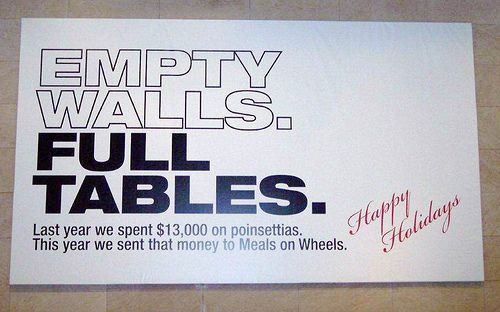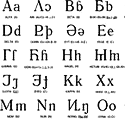December 2010
Do Good Design
Lovely type from Brian Gosset. Happy New Year!

A Gift of Flowers
Katya, of non-profit marketing blog, spotted this in the lobby of a tony midtown office building:

It’s a nice gesture — and I’m certainly going to think of this wherever I see those red flowers this season.
I heard the design process was quite contentious at the FTC before settling on the familiar motif. The yellow EnergyGuide label has been used since the 1970’s for washing machines, refrigerators, and other large appliances sold in the US but never before for electronics. By making long term costs visible at the point of purchase, this humble bit of information design has saved an enormous amount of resources over the last 30+ years. It’s also a nice nudge to manufacturers who know the information will be public.

 The results of Ann Thorpe’s design activism survey are in: ask 100 designers and get 100 different answers. But some curious trends do emerge. For instance, who knew product designers were so much more engaged than other types of designers?
The results of Ann Thorpe’s design activism survey are in: ask 100 designers and get 100 different answers. But some curious trends do emerge. For instance, who knew product designers were so much more engaged than other types of designers?Update 12/21/10: Ann has posted a list of respondent suggestions for learning more about design activism.
Influencing Behavior through Design
“All design influences our behaviour, but as designers we don’t always consciously consider the power this gives us to help people, (and, sometimes, to manipulate them).”
Dan Lockton has posted a fantastic resource, Design with Intent. Formerly known as Architecture of Control, this book of cards features 101 design patterns for influencing behavior through form, feedback, and interface. The techniques span media from architecture and product design, to signage, interaction and graphic design and influence users by making choices easy, difficult, confusing or fun in sometimes subtle or provocative ways. The cards are organized by mode as follows:
You can download the complete set here. It’s a great primer on interaction design in the real world and a useful lens for looking at the politics of access and usability and the quiet frameworks of design and power that shape our daily lives.
Type and Nation, 5

Via Language Log I found this bit on Another battle of the alphabets shaping up in Central Asia:
“A statement by a Kazakhstan minister that his country will eventually shift from a Cyrillic-based alphabet to a Latin-based script and reports that some scholars in Dushanbe are considering dropping another four Russian letters from the Tajik alphabet suggest that a new battle of the alphabets may again be shaping up in Central Asia.
Russian commentators have reacted by suggesting that this is yet another effort by nationalists in those countries to reduce the role of the Russian language and hence of the influence of Russian culture, but in fact the controversy over any such change is far more complicated than that.”
Not a new story, Kazakhstan conducted a feasibility study on the switch back in 2007, but it seems to be gaining momentum. And not just a matter of international geopolitics either — Kazakhstan has a sizable Russian population in the north, a source of tension within the country.
While Cyrillic is the official script of Kazakhstan, the Latin alphabet is already used by the Kazakh diaspora in Turkey, Western Europe and the US, while Kazakhs in China use a modified Arabic alphabet. There’s more on Kazakh alphabets on Wikipedia and more on typography and nationalism here.


